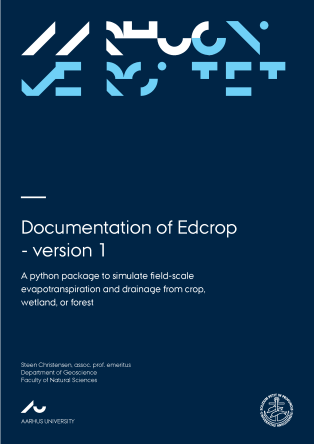Documentation of Edcrop – version 1: A Python package to simulate field-scale evapotranspiration and drainage from crop, wetland, or forest
Nøgleord:
Root zone, evapotranspiration, evaporation, transpiration, soil drainage, macro pore, crop, wetland, forest, irrigation, model, simulation, python, package, module, script, precipitation, snow, rain, interceptionSynopsis
Evapotranspiration is one of the major components of Earth’s Water Balance, being the sum of evaporation and plant transpiration from the land and ocean surface. This report documents edcrop, a Python package that use climate input to simulate field-scale evapotranspiration and drainage from the root zone of an area covered with a crop, a wetland, or a forest.
The conceptual model implemented in edcrop is a modification of the Evacrop model by Olesen and Heidmann (2002), which itself builds on the Watcros model by Aslyng and Hansen (1982). The edcrop conceptualization is based on considerations regarding the physical processes that are important for turning precipitation and irrigation into either evaporation, transpiration, or drainage from the root zone: Temperature determines whether precipitation falls as rain or snow, and it determines when snow thaws and infiltrates. The vegetation intercepts a part of precipitation, while the rest infiltrates into the ground. The infiltrated water will either evaporate, be absorbed by plant roots, be stored in the soil, or drain from the root zone. Potential evaporation is distributed between vegetation and soil, where the former part drives evaporation of intercepted water and plant transpiration from the green leaf area, while the latter part drives evaporation from the soil. The soil’s ability to store water depends on its field capacity; when the water content exceeds field capacity, water will gradually drain downwards. Furthermore, it is assumed that the annual life cycle of crops and wetland vegetation can be described by growing degree-days alone, while for forests the life cycle is described by a calendar. For irrigation, either (i) date and amount are input, or (ii) they are determined automatically by edcrop using certain criteria.
There are two alternative soil water balance functions to choose between in edcrop. The first alternative is an almost straight copy of the function used in the original Evacrop code by Olesen and Heidmann (2002), simulating flow through the soil profile as flow through two linear reservoirs using daily time steps. However, it can simulate macro-pore drainage, which the original Evacrop cannot. The second alternative simulates flow through the soil profile as flow through four linear or nonlinear reservoirs using daily or sub-daily time steps. For nonlinear reservoirs, edcrop uses Mualem – van Genuchten like functions. It also simulates gravity driven macro-pore flow as well as precipitation loss due to surface runoff.
As input, given in text files, edcrop requires daily temperature, precipitation, and reference evapotranspiration. It also requires information about combination(s) of soil type and vegetation type to simulate. One can choose between seven default soil types and fifteen default vegetation types, or one can manually input information for other types of soil or vegetation. In a single model run, edcrop can loop through lists of climate files, soils, and vegetation.
Edcrop can be imported and used in own python script, or it can be executed from the command line as a script.
Referencer
Abrahamsen, P. (2020). Daisy Program Reference Manual. Department of Plant and Environmental Sciences, University of Copenhagen, February 3, 2020. 624 pp. https://daisy.ku.dk/.
Ahuja, L.R., Rojas, K.W., Hanson, J.D., Shaffer, M.J., and Ma, L. (2000): Root Zone Water Quality Model – Modeling management effects on water quality and crop production. Water Resources Publications, LLC. Colorado, USA, 372 pp.
Allen, R.G., Pereira, L.S., Raes, D., and Smith, M. (1998). Crop Evapotranspiration—Guidelines for Computing Crop Water Requirements. FAO Irrigation and drainage paper 56. Rome, Italy: Food and Agriculture Organization of the United Nations. ISBN 92-5-104219-5. http://www.fao.org/3/X0490E/x0490e00.htm.
Aslyng, H.C. & Hansen, S. (1982). Water Balance and Crop Production Simulation. Hydrotechnical Laboratory. The Royal Veterinary and Agricultural University. Copenhagen. 200 pp.
Doherty, J. (2010). PEST – Model-Independent Parameter Estimation, User Manual, 5th Edition. Watermark Numerical Computing. 336 pp. https://pesthomepage.org/documentation.
Foley, J.A., Prentice, I.C., Ramankutty, N., Levis, S., Pollard, D., Sitch, S., and Haxeltime, A. (1996). An integrated biosphere model of land surface processes, terrestrial carbon balance, and vegetation dynamics. Global Biogeochemical Cycles, 10(4), p. 603-628.
Hansen, S., Jensen, H.E., Nielsen, N.E., and Svendsen, H. (1990). DAISY – Soil Plant Atmosphere System Model. NPo-forskning fra Miljøstyrelsen, Nr. A10. Miljøstyrelsen, København. 272 pp.
Healey, R.W. (2010). Estimating groundwater recharge. Cambridge University Press, 245 pages.
Madsen, H.B., and Holst, K. (1987). Potentielle marginaljorder - Landsdækkende kortlægning af jordbundsfysiske og kemiske forhold, der har indflydelse på jordens dyrkning. Marginaljorder og miljøinteresser. Miljøministeriets projektundersøgelser 1986, Teknikerrapport nr. 1.
McDonald, M.G., and Harbaugh, A.W. (1988). A Modular Three-Dimensional Finite-Difference Ground-Water Flow Model. U.S. Geological Survey, Techniques of Water-Resources Investigations, Book 6, Chapter A1.
Murray, M.B., Cannell, M.G.R., and Smith, R.I. (1989). Date of budburst of fifteen tree species in Britain following climatic warming. Journal of Applied Ecology, 26, p. 603-700.
Olesen, J.E., and Heidmann, T. (2002). EVACROP – Et program til beregning af aktuel fordampning og afstrømning fra rodzonen, Version 1.01. Afdeling for Plantevækst og Jord og Afdeling for Jordbrugssystemer, Forskningscenter Foulum, Tjele, Danmark.
Refsgaard, J.C., Stisen, S., Højbjerg, A.L., Olsen, M., Henriksen, H.J., Børgesen, C.D., Vejen, F., Kern-Hansen, C., and Blicher-Mathiesen, G. (2011). Vandbalance i Danmark – Vejledning i opgørelse af vandbalance ud fra hydrologiske data for perioden 1990-2010. Danmarks og Grønlands Geologiske Undersøgelse, Rapport 2011/77.
Schaap, M.G., and van Genuchten, M.T. (2006). A Modified Mualem–van Genuchten Formulation for Improved Description of the Hydraulic Conductivity Near Saturation. Vadose Zone Journal 5, p. 27–34, doi:10.2136/vzj2005.0005.
Stisen, S., Sonnenborg, T.O., Højbjerg, A.L., Troldborg, L., Refsgaard, J.C. (2011): Evaluation of Climate Input Biases and Water Balance Issues Using a Coupled Surface–Subsurface Model. Vadose Zone Journal, 10, p. 37–53, doi:10.2136/vzj2010.0001.

